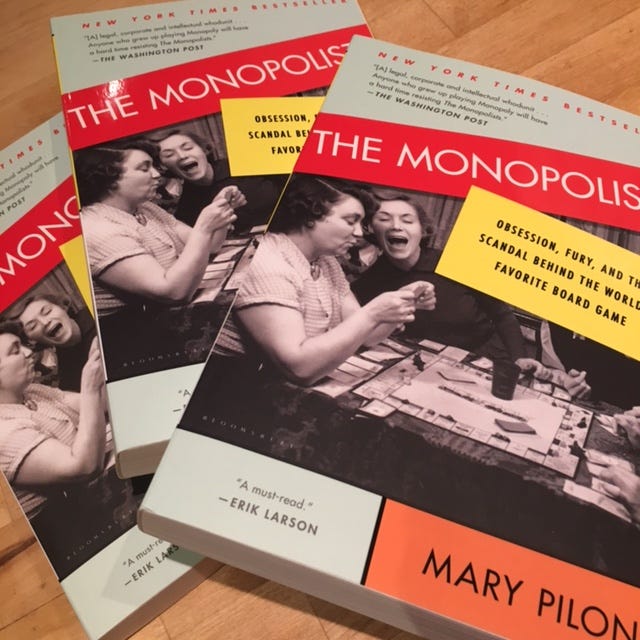Behind the Cardboard Streets
The true history of the Atlantic City Monopoly board
Most of us are familiar with the Monopoly board — the slums of Baltic and Mediterranean Avenues, the lucrative strip of plum and orange properties leading to Free Parking, the glitz of Park Place and Boardwalk. But fewer players of the game are aware that its origins date back not to the Great Depression, but to a woman, Lizzie Magie, who received a patent for her Landlord’s Game in 1904. So how did a woman living in Washington, D.C., create an Atlantic City icon? In this excerpt from The Monopolists, author Mary Pilon explores the secret history of the game and its makers.
In the 1850s, a New Jersey physician named Jonathan Pitney envisioned a place for city dwellers to go to escape the dank and exhausting conditions of urban life — a health resort by the sea, a place reachable by rail.
Shortly thereafter, Atlantic City was born, and its first few hundred visitors arrived. In 1870, the first section of the soon-to-be-famous Boardwalk — the first of its kind in the country — went up, and in 1875, the Atlantic City Gas and Water Company was formed, helping to turn Atlantic City into a playground for adults. At that time, water and electricity were not yet widespread public goods, and the technology seemed relatively novel and decadent. Hotels popped up like gleaming castles in the sand, along with more ordinary boardinghouses, which were the true backbone of the city, as they catered to the thousands of middle-class tourists who started pouring in, many arriving by rail from nearby cities like Philadelphia and New York.
The board game Monopoly, too, had traveled in similar circles, having been embraced by left wing intellectuals throughout the Northeast. Among those who arrived — and then took up residence — in Atlantic City were a group of Quakers, who hoped to establish a healthy, fresh-air community, complete with modest accommodations and prayer lodges. Others who decided to settle in the new resort town came from New York City; Newark and Trenton, New Jersey; and other northeastern cities, with the wealthier among them building impressive-looking homes on States Avenue.
One of Atlantic City’s most famous landmarks, the Steel Pier, went up at the turn of the century. An unrivaled entertainment venue located on the Boardwalk, it hosted opera, theater, movies, concerts headlined by John Philip Sousa, and, later, high-diving horses and boxing cats. The Boardwalk was a mecca for marketers, who knew that they could reach millions of middle-class urbanites from all over the Northeast in one place.
Fans of Boardwalk Empire know that Prohibition cleaved Atlantic City in two.
On one side were the masters of vice and those who tolerated that vice because of the wealth pouring into the town. On the other side were the reformists, including the Quakers, who wanted Atlantic City to be a clean, middle-class getaway, not a sordid playground. The reformists tried to avoid the clamor of the city’s proudly flaunted debauchery, but that was hard to do — their own neighbors were often among the city’s darker characters.
Hotels were the undisputed kings of Atlantic City, with their owners engaged in a race to create the best and grandest accommodations ever seen. On Indiana Avenue reigned the magnificent Brighton Hotel, and on Park Place and the Boardwalk shone the Marlborough-Blenheim Hotel, the first “fireproof” building in town, its construction of reinforced concrete super- vised by Thomas Edison and designed by Quaker William Price, the same man who had designed the modest cottages of utopian Arden, Del.
Ironically, some of the city’s most famous and elegant hotels were owned by simplicity-loving Quakers and single-taxers like Price. On North Carolina Avenue was the Quaker-owned Chalfonte-Haddon Hall, which served no alcohol and was known for its elegant teas, available in posh dining rooms set with white porcelain and silver teapots. On Virginia Avenue was the Quaker-owned Morton Hotel, and nearby was the Quaker- owned Glaslyn Chatham. The St. Charles Hotel on St. Charles Place was a favorite venue among single-taxers for their regular meetings, thanks to its large porch, rocking chairs, and bay windows overlooking the sea.
Among the many institutions funded by the wealthy Quaker Atlantic City hoteliers was the Atlantic City Friends School, where pretty Ruth Hoskins, a recent college graduate, went to work as a teacher in 1929, just before the stock market crash. Hoskins brought with her a board game that she had learned in Indianapolis the winter before from her friends Pete and James Daggett.
The Daggett brothers had called the game “monopoly,” and they showed Hoskins how to make her own handmade board, complete with residential properties, railroads, and utilities.
All the board’s property names referenced midwestern and northeastern locales — among them Grosse Pointe (Michigan) and the Bowery (New York City). The board had Jail and Go to Jail spaces, and players received $200 every time they passed Go.
Ruth introduced the game to other Quakers in Atlantic City, including Cyril and Ruth Harvey, who also taught at the Atlantic City Friends School. The Harveys’ six-year-old daughter, Dorothy Alice, better known as Dottie, was a student at the school, and the family lived not far from the famed Boardwalk.
Dottie often went with her mother to buy supplies for the game, such as paper for making play money, at a little store owned by a Jewish family on Atlantic Avenue. Sometimes, when they ran out of paper for making the Community Chest and Chance cards, they improvised by using Old Maid cards on which they typed instructions such as “Go by GO and take 200 dollars.”
Community chests started appearing before World War I, when businessmen formed volunteer-based organizations to pool donations from around their communities, perhaps inspiring the spaces on the board that sometimes offered players good fortune. At some point, a corner space on the board that had previously been a community park turned into Free Parking. Atlantic City hotels had started using that phrase in their marketing materials, as more and more travelers were now arriving by car rather than by rail.
Jesse Raiford, a real estate agent and a friend of the Harveys, assisted Ruth by making little wooden boxes to use as the game’s houses. Jesse then experimented with using color sequences on the board, finally deciding to divide the properties into groups of three. Closely familiar with Atlantic City property values, he also affixed prices to the game board. Dottie was more interested in the tokens that players pulled out of their pockets to play the game — a tie clip, a penny, an earring.
The streets on the board mirrored the Quaker social network.
The Harveys themselves lived on Pennsylvania Avenue, while their friends the Joneses lived on Park Place, an expensive part of town, and the Copes lived on Virginia Avenue, at the Quaker-owned Morton Hotel. Ventnor Avenue was where the Harveys had lived when Dottie was younger, and the Boardwalk was where they often went for a stroll.
Better-off neighborhoods like Margate and Ventnor had high walls and fences and neighborhood covenants that made clear that African American families were not welcome, even though they made up as much as a fifth of the city’s overall population. Most blacks were relegated to working service jobs, but there was a thriving black business community and a network of entertainment venues on Kentucky Avenue — or “Ky. at the curb,” as locals called it — within earshot of the segregated beaches along the Boardwalk. Kentucky Avenue had a movie theater and vibrant clubs, including Club Harlem, which often catered to white guests. On Illinois Avenue stood the Paradise Club, where the Count Basie Orchestra played, and at one end of Indiana Avenue was a black beach — until the owners of the nearby Claridge Hotel complained. Chinese restaurants and kosher eateries and shops thrived on Oriental Avenue and Pacific Avenue, the latter also home to the Post Office Building, where FBI agents would call witnesses in their attempt to take down Nucky Johnson.
The Harveys employed a black maid, Clara Watson, whom they adored. Clara lived in one of the poorer African American neighborhoods, on Baltic Avenue, right near Mediterranean Avenue, where an economy separate from that of the grand hotels existed. Poor white residents and prostitutes also lived nearby. The placement of these poorer properties on the monopoly board reflected the harsh reality of the city — a reality that was not acknowledged in the tourist brochures or perky postcards.
The Atlantic City streets often acted as fences, segmenting the town’s population by race, religion, ethnicity, economic status, and, in some places, sexual preference.
New York Avenue gained a reputation for male prostitution and was home to some of the earliest gay bars in the country. Prostitution of all kinds was prevalent in Atlantic City, with black and white men and women selling their wares to a wide swath of customers.
Much of the resort’s round-the-clock activity came to a halt with the stock market crash in 1929. Some families, including the Harveys, began renting out spare rooms to impoverished friends and neighbors, while others who were down on their luck found refuge in steeply discounted surplus hotel rooms, a trend which made its way onto the boards of the Atlantic City monopoly game.
Sometimes, Quaker arguments were about whether or not to allow the auctioning off of properties, a feature Lizzie Magie had included in her 1924 Landlord’s Game patent. In the real world, most Quakers did not care for the noise associated with auctions or that they created the potential for sellers to lie to and mistreat consumers. Thus, many around the Harveys’ table who held silence to be a tenant of their faith were against allowing auctioneering to be part of the game.
Most Quakers considered monopoly to be a game for adults, but sometimes children joined in, usually playing with their parents as a team. And when they did, auctioneering became even more unpopular. Auctions were complicated, and most children didn’t have the skills or interest to conduct them.
Slowly, the auctioneering option of Lizzie Magie’s game began to lose emphasis among the Atlantic City players. Just as a modified version of the Landlord’s Game had spread in Arden years earlier, so now a modified version of the monopoly game spread among the Quakers.
The Harveys and their friends didn’t bother writing down the game’s rules. They knew how to play; they didn’t need written instructions. The roll of the dice was a matter of chance, but how a player reacted to that roll, along with his or her deal-making skills, determined who won the game. This very deal-making aspect of the game, however, as well as its use of still morally-suspect dice, made some players nervous about playing monopoly.
It’s a version of this game that a man named Charles Todd taught his friend, Charles Darrow. When Todd copied the board, using the Raifords’ board as his guide, he had inadvertently made a spelling error. Instead of writing “Marven Gardens,” the name of the Atlantic City housing area in Margate on Ventnor Avenue, he had written “Marvin Gardens,” substituting an “i” for an “e.”
That one-letter slip was to become one of the most repeated spelling
errors in history.
Excerpted from The Monopolists: Obsession, Fury, and the Scandal Behind the World’s Favorite Board Game by Mary Pilon. Published February 17, 2015 by Bloomsbury USA.
Available for purchase from Amazon, Barnes & Noble, and your local independent.









